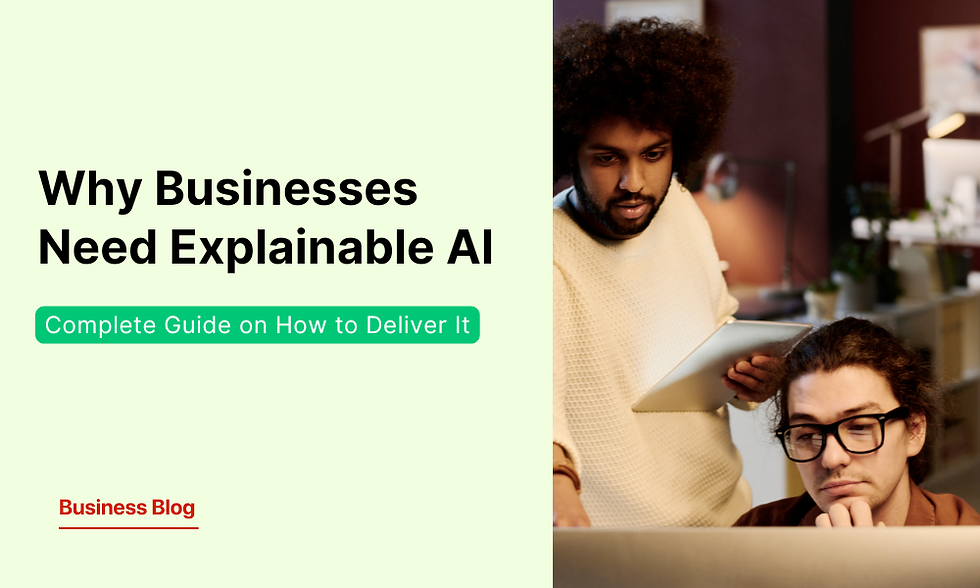Comprehensive Guide to Explainable AI Standards, Methodologies, and Best Practices
- Olivia Johnson

- Jul 31
- 7 min read
What Is Explainable AI?

Explainable AI (XAI) refers to artificial intelligence systems designed to be transparent, interpretable, and accountable. Unlike traditional "black box" AI models whose decision-making processes are obscure, XAI emphasizes clarity in how models operate and generate outputs. This transparency is crucial for fostering trust among users, meeting regulatory demands, and enabling organizations to adopt AI responsibly, especially in high-stakes domains such as healthcare, finance, and autonomous systems.
In 2025, the importance of AI transparency and interpretability continues to grow as global regulations tighten and stakeholders demand ethical AI deployment. Organizations increasingly recognize that without explainability, AI adoption risks stagnation due to mistrust and compliance failures.
The Evolution and Importance of Explainable AI

From Black Box to Glass Box: Why Explainability Matters
Historically, many AI systems operated as black boxes, where the internal reasoning behind predictions was inaccessible—even to their creators. While these models, particularly deep learning networks, excelled in accuracy, their opaque nature posed significant challenges:
Trust Deficit: Users found it difficult to trust decisions they couldn’t understand.
Ethical Concerns: Unexplainable decisions risk perpetuating biases or unfair treatment.
Safety Risks: In safety-critical applications like autonomous driving or medical diagnosis, understanding model rationale is essential.
The shift toward glass box models—AI systems that provide transparent reasoning—addresses these issues by making outcomes interpretable and justifiable. This transition enhances AI safety, supports ethical frameworks, and improves user confidence.
Regulatory Pressures and Industry Drivers
Regulatory bodies worldwide have elevated explainability from a best practice to a core requirement:
The General Data Protection Regulation (GDPR) mandates the right to explanation when automated decisions affect individuals.
The U.S. Food and Drug Administration (FDA) issues guidelines for AI/ML-based medical devices that emphasize transparency.
Financial regulators increasingly require explainability for algorithmic credit decisions.
A recent industry survey found that 68% of organizations cite lack of explainability as a major barrier to AI adoption in regulated sectors. These pressures accelerate the evolution and adoption of XAI methodologies.
Key Milestones in XAI Development
2016: DARPA launches the XAI program to develop interpretable AI.
2019: NIST publishes initial guidelines on trustworthy AI including explainability.
2021: ISO begins formalizing standards around AI transparency.
2023: EU proposes the AI Act with explicit explainability requirements for high-risk AI systems.
For more on ethical frameworks and regulatory compliance, explore our foundational article on AI ethics and the authoritative NIST AI Risk Management Framework.
Overview of XAI Standards and Regulatory Frameworks

International and Industry Standards
Several international organizations have developed standards providing frameworks for explainability:
ISO/IEC JTC 1/SC 42 focuses on AI standards including transparency and interpretability.
IEEE P7001 standardizes transparency in autonomous systems.
The National Institute of Standards and Technology (NIST) offers comprehensive guidance on Explainable AI aimed at building trustworthy systems.
The FDA’s guiding principles for AI/ML in healthcare mandate rigorously documented explainability for patient safety.
Regulatory Landscape and Compliance
Explainability is a cornerstone for compliance across major regulations:
GDPR requires meaningful information about algorithmic logic affecting individuals.
The EU AI Act, pending enactment, categorizes high-risk AI systems mandating transparency and documentation.
In the US, emerging federal and state regulations are aligning with global standards emphasizing explainability for accountability.
By implementing XAI standards, organizations enable auditability and maintain accountability throughout the AI lifecycle—crucial for both legal compliance and public trust.
Industry-Specific Standards
Different sectors tailor XAI requirements based on domain-specific risks:
Industry | Key Explainability Focus | Notable Standards & Guidelines |
|---|---|---|
Healthcare | Clinical decision support, patient safety | FDA AI/ML Software guidelines |
Finance | Credit risk modeling, fraud detection | Basel Committee principles, SEC audits |
Automotive | Autonomous systems safety, transparency | ISO 26262 functional safety, SAE standards |
Core Methodologies in Explainable AI

Model-Agnostic Methods
Model-agnostic approaches provide explanations applicable across various AI models without altering them:
SHAP (SHapley Additive exPlanations) uses cooperative game theory to assign contribution scores to each feature in a prediction.
LIME (Local Interpretable Model-agnostic Explanations) approximates complex models locally with interpretable surrogate models to explain individual predictions.
Other techniques include counterfactual explanations which describe how inputs must change to alter outputs, and Individual Conditional Expectation (ICE) plots that visualize model output changes across feature ranges.
Interpretable Models
Some algorithms are inherently transparent:
Decision Trees offer clear rule paths.
Linear/Logistic Regression provides coefficient interpretations tied directly to feature influence.
Rule-Based Systems encode human-readable conditions.
These models often trade some accuracy for better interpretability but are preferred when explainability is critical.
Visualization Techniques
Visual tools help users grasp complex model behavior:
Feature importance charts highlight key drivers.
Saliency maps emphasize regions influencing CNN outputs in computer vision tasks.
In NLP, attention visualizations reveal which words influence text classification.
These techniques are vital in fields like medical imaging where visual interpretability aids clinical validation (source).
Global vs. Local Explanations
Global explanations describe overall model behavior across the dataset.
Local explanations focus on individual predictions.
Choosing between them depends on use cases: global explanations support model validation; local explanations aid end-user understanding.
For practical implementation advice, see our guide on integrating XAI into ML workflows.
Where Explainable AI Makes an Impact

Healthcare and Medical Devices
Explainability is pivotal in clinical decision support:
XAI helps clinicians understand AI-driven diagnostics or treatment recommendations.
FDA guidelines require transparent models to ensure safety and efficacy.
For example, an interpretable model detecting diabetic retinopathy enables ophthalmologists to verify results against known clinical features.
Finance and Risk Modeling
In finance, XAI underpins fair lending practices and fraud detection:
Loan approval models must justify decisions to comply with anti-discrimination laws.
Fraud detection algorithms require audit trails for regulatory scrutiny.
Explainability enhances model validation and trust between institutions and customers.
Autonomous Vehicles and Transportation
Safety-critical decisions by autonomous vehicles necessitate transparency:
Companies like Tesla and Waymo invest in explainability tools to trace decision logic during navigation.
Understanding why a vehicle made specific maneuvers aids accident investigations and regulatory compliance.
Business Decision Intelligence
Explainable AI improves operational decisions across functions:
Marketing leverages interpretable customer segmentation models.
HR uses transparent analytics for unbiased talent acquisition.
Financial analytics benefit from clear risk assessment reports.
For industry-specific solutions, explore our AI in business applications collection.
Case studies highlighting real-world XAI impacts are available through reputable research portals such as IEEE Xplore or ACM Digital Library.
Why Organizations Need Explainable AI

Building Trust and User Confidence
Transparent AI fosters stakeholder buy-in by demystifying decisions:
“Explainability transforms opaque algorithms into understandable tools, increasing user confidence and adoption.”
Studies show that organizations adopting XAI see improved customer trust and higher acceptance rates.
Compliance and Risk Management
Explainable models facilitate easier adherence to regulations by enabling thorough audits. They also reduce operational risks by exposing hidden biases or errors early.
Enhanced Model Performance and Debugging
XAI helps data scientists identify problematic features or data inconsistencies that degrade model accuracy or fairness. For instance:
Detecting data leakage.
Uncovering bias towards specific demographic groups.
This leads to more robust and ethical AI deployments.
Ethical Considerations and Social Responsibility
Explainability aligns with principles of fairness, transparency, and accountability—core pillars of responsible AI. It empowers organizations to demonstrate social responsibility effectively.
Overcoming Barriers in Explainable AI Adoption

Technical Complexity and Trade-offs
Balancing model accuracy with interpretability remains challenging:
Deep learning models often yield superior performance but lack inherent explainability.
Simplifying models can reduce predictive power.
Hybrid approaches combining interpretable components with complex architectures are emerging solutions.
Standardization and Benchmarking Gaps
Currently, inconsistent standards across industries hinder uniform adoption of XAI. Efforts by ISO, IEEE, and NIST aim to close these gaps but full harmonization is ongoing.
User Understanding and Trust
Even technically sound explanations may fail if they are too complex or abstract for end-users. Effective communication tailored to diverse audiences is essential.
Data Privacy and Security Concerns
Revealing internal model logic can inadvertently expose sensitive data or proprietary information. Balancing transparency with privacy remains an active research area.
How to Successfully Implement Explainable AI

Selecting the Right XAI Techniques
Choose explainability methods based on:
Model type (e.g., SHAP for tree ensembles).
Stakeholder needs (technical vs. non-technical).
Regulatory requirements.
Prioritize methods balancing interpretability with sufficient fidelity.
Integrating XAI into AI Pipelines
Embed explainability throughout:
Data preprocessing with documentation of feature importance.
Model training with built-in interpretability checks.
Deployment with explanation APIs accessible to end-users.
Post-deployment monitoring for drift affecting explanations.
Stakeholder Communication and Training
Tailor explanations using visual aids or plain language summaries for non-experts while providing technical reports for data scientists or auditors.
Training programs improve organizational literacy around XAI benefits and constraints.
Continuous Monitoring and Governance
Establish oversight mechanisms ensuring explanations remain accurate as models evolve. Update XAI tools regularly aligned with new standards or business needs.
What’s Next for Explainable AI?

Emerging Trends and Technologies
The XAI market is expanding rapidly with innovations including:
Automated explanation generation using natural language processing.
Hybrid interpretable deep learning architectures.
Enhanced visualization platforms integrating multimodal data.
Governance frameworks continue evolving alongside stricter regulatory expectations globally.
Actionable Insights for Organizations
Immediate steps:
Audit existing AI models for explainability gaps.
Align development pipelines with recognized standards.
Invest in staff training focusing on interpretability skills.
Long-term strategies include staying abreast of evolving regulations, emerging tools, and market shifts to maintain competitive responsible AI practices.
The Path Toward Responsible and Trustworthy AI
Explainable AI will be a cornerstone for future human-centric AI systems that prioritize ethics alongside performance—transforming how society interacts with intelligent technology.
FAQ: Comprehensive Guide to Explainable AI Standards Methodologies and Best Practices
What is Explainable AI (XAI)? XAI refers to methods that make AI decisions understandable by humans through transparency and interpretability techniques.
Why is explainability important in AI? It builds trust, ensures ethical compliance, supports regulatory adherence, and improves safety in critical applications.
What are the main standards for XAI in 2025? Key standards include ISO/IEC SC42 guidelines, IEEE P7001 transparency standard, NIST’s Explainable AI framework, FDA’s guidance for medical devices, GDPR provisions, and the upcoming EU AI Act.
How do SHAP and LIME work? SHAP assigns contribution values based on game theory; LIME approximates local predictions with simpler surrogate models—both providing feature-level explanations independent of underlying algorithms.
Which industries benefit most from explainable AI? Healthcare, finance, autonomous vehicles, and business intelligence sectors have significant needs due to high stakes around fairness, safety, or compliance.
What are the main challenges in adopting XAI? Challenges include balancing accuracy with interpretability, lack of consistent standards, communication difficulties, and privacy concerns regarding exposure of sensitive model logic.
How do I choose the right explainability method? Select based on model type, stakeholder audience, regulatory needs, and whether local or global explanations are required.
What are the future trends in XAI? Expect growth in automated explanations, hybrid interpretable architectures, stronger governance frameworks, and widespread integration into MLOps pipelines.


